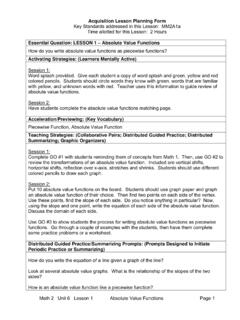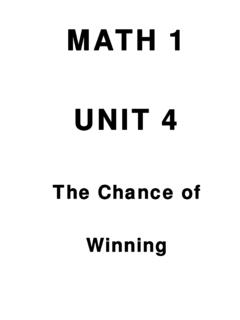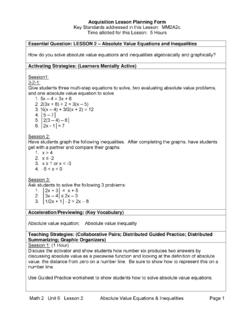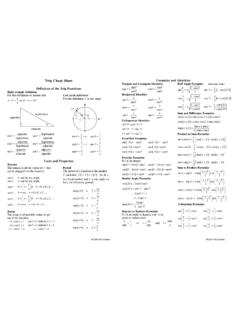Transcription of MATH 1 - ciclt.net
1 math 1 UNIT 1: FUNCTION FAMILIES Page 2 Page 3 math 1 UNIT 1 FUNCTION FAMILIES CONTENT MAP Unit 1 Function Families (4 Weeks) Essential Question: How do you analyze and interpret the characteristics of linear, quadratic, cubic, absolute value, square root, and rational functions using graphs, tables, and simple algebraic techniques? Lesson 1 functions (2 Hours): Essential Questions What are the characteristics of a function and how can you use those characteristics to represent the function in multiple ways? Lesson 2 -- Linear functions (1 Hour): Essential Question How do you analyze and graph linear functions ? Lesson 3 -- Absolute Value functions (4 Hours): Essential Question How will I analyze and graph an absolute value function and how will they be affected by various transformations? Lesson 4 -- Quadratic functions (3 Hours): Essential Question How do you analyze and graph quadratic functions and how will they be affected by various transformations?
2 Lesson 5 -- Cubic functions (3 Hours): Essential Question How do you analyze and graph cubic functions and how will they be affected by various transformations? Lesson 6 -- Square Root functions (2 Hours): Essential Question How do you analyze and graph square root functions and how will they be affected by various transformations? Lesson 7 -- Rational functions (2 Hours): Essential Question How do you analyze and graph rational functions ? Lesson 8 Sequences as functions (1 Hour): Essential Question How can sequences be expressed and manipulated as functions ? Lesson 9 Logic How do you apply the forms and relationships of conditional statements to real life applications? Summarizer & Evaluation of Unit 1 (2 Hours) Mathematics I Unit 1: Function Families INTRODUCTION: In seventh and eighth grade, students learned about functions generally and about linear functions specifically.
3 This unit explores properties of basic quadratic, cubic, absolute value, square root, and rational functions as well as new language and notation for talking about functions . The discussion of function characteristics includes further development of the language of mathematical reasoning to include formal discussion of the logical relationships between a statement and its converse, inverse, and contrapositive. ENDURING UNDERSTANDINGS: functions have three parts: (i) a domain, which is the set of inputs for the function, (ii) (ii) a range, which is the set of outputs, and (iii) (iii) some rule or statement of correspondence indicating how each input determines a unique output. The domain and rule of correspondence determine the range of a function. Graphs are geometric representations of functions . functions are equal if they have the same domain and rule of correspondence.
4 Function notation provides an efficient way to define and communicate functions . The variables used to represent domain values, range values, and the function as a whole, are arbitrary. Changing variable names does not change the function. Logical equivalence is a concept that applies to the form of a conditional statement. A conditional statement and its contrapositive are logically equivalent. Neither the converse nor inverse of a conditional statement is logically equivalent to the statement. KEY STANDARDS ADDRESSED: MM1A1. Students will explore and interpret the characteristics of functions , using graphs, tables, and simple algebraic techniques. a. Represent functions using function notation. b. Graph the basic functions f(x) = xn where n = 1 to 3, f(x) = x, f(x) = |x|, and f(x) = 1x. c. Graph transformations of basic functions including vertical shifts, stretches, and shrinks, as well as reflections across the x- and y-axes.
5 [Previewed in this unit.] d. Investigate and explain the characteristics of a function: domain, range, zeros, intercepts, intervals of increase and decrease, maximum and minimum values, and end behavior. e. Relate to a given context the characteristics of a function, and use graphs and tables to investigate its behavior. f. Recognize sequences as functions with domains that are whole numbers. g. Explore rates of change, comparing constant rates of change ( , slope) versus variable rates of change. Compare rates of change of linear, quadratic, square root, and other function families. MM1G2. Students will understand and use the language of mathematical argument and justification. a. Use conjecture, inductive reasoning, deductive reasoning, counterexamples, and indirect proof as appropriate. b. Understand and use the relationships among a statement and its converse, inverse, and contrapositive.
6 Page 4 Page 5 RELATED STANDARDS ADDRESSED: MM1A1. Students will explore and interpret the characteristics of functions , using graphs, tables, and simple algebraic techniques. i. Understand that any equation in x can be interpreted as the equation f(x) = g(x), and interpret the solutions of the equation as the x-value(s) of the intersection point(s) of the graphs of y = f(x) and y = g(x). MM1A2. Students will simplify and operate with radical expressions, polynomials, and rational expressions. a. Simplify algebraic and numeric expressions involving square root. b. Perform operations with square roots. e. Add, subtract, multiply, and divide rational expressions. MM1P1. Students will solve problems (using appropriate technology). a. Build new mathematical knowledge through problem solving. b. Solve problems that arise in mathematics and in other contexts. c.
7 Apply and adapt a variety of appropriate strategies to solve problems. d. Monitor and reflect on the process of mathematical problem solving. MM1P2. Students will reason and evaluate mathematical arguments. a. Recognize reasoning and proof as fundamental aspects of mathematics. b. Make and investigate mathematical conjectures. c. Develop and evaluate mathematical arguments and proofs. d. Select and use various types of reasoning and methods of proof. MM1P3. Students will communicate mathematically. a. Organize and consolidate their mathematical thinking through communication. b. Communicate their mathematical thinking coherently and clearly to peers, teachers, and others. c. Analyze and evaluate the mathematical thinking and strategies of others. d. Use the language of mathematics to express mathematical ideas precisely. MM1P4. Students will make connections among mathematical ideas and to other disciplines.
8 A. Recognize and use connections among mathematical ideas. b. Understand how mathematical ideas interconnect and build on one another to produce a coherent whole. c. Recognize and apply mathematics in contexts outside of mathematics. MM1P5. Students will represent mathematics in multiple ways. a. Create and use representations to organize, record, and communicate mathematical ideas. b. Select, apply, and translate among mathematical representations to solve problems. c. Use representations to model and interpret physical, social, and mathematical phenomena. Page 6 UNIT OVERVIEW: Prior to this unit, students need to have worked extensively with operations on integers, rational numbers, and square roots of nonnegative integers as indicated in the Grade 6 8 standards for Number and Operations. In the unit students will apply and extend the Grade 7 8 standards related to writing algebraic expressions, evaluating quantities using algebraic expressions, understanding inequalities in one variable, and understanding relations and linear functions as they develop much deeper and more sophisticated understanding of relationships between two variables.
9 Students are assumed to have a deep understanding of linear relationships between variable quantities. Students should understand how to find the areas of triangles, rectangles, squares, and circles and the volumes of rectangular solids. The unit begins with intensive work with function notation. Students learn to use function notation to ask and answer questions about functional relationships presented in tabular, graphical, and algebraic form. The distinction between discrete and continuous domains is explored through comparing and contrasting functions which have the same rule of correspondence, but different domains. Through extensive work with reading and drawing graphs, students learn to view graphs of functional relationships as whole objects rather than collections of individual points and to apply standard techniques used to draw representative graphs of functions with unbounded domains.
10 The unit includes an introduction to propositional logic of conditional statements, their converses, inverses, and contrapositives. Conditional statements about the absolute value function and vertical translations of the absolute value function give students concrete examples that can be classified as true or false by examining graphs. Combining analysis of conditional statements with further exploration of basic functions demonstrates that conditional statements are important throughout the study of mathematics, not just in geometry where this material has traditionally been introduced. Average rate of change of a function is introduced through the interpretation of average speed, but is extended to the context of rate of change of revenue for varying quantities of a product sold. Students contrast constant rates of change to variable ones through the concept of average rate of change.







